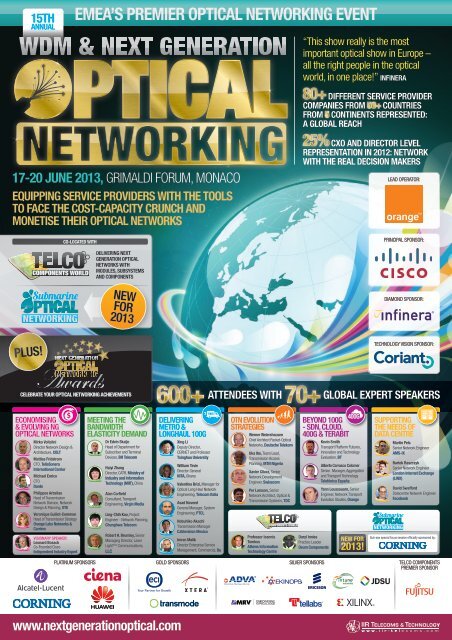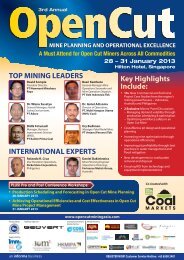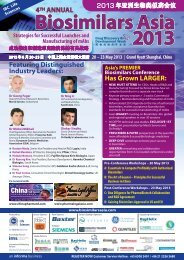EMEA'S PREMIER OPTICAL NETWORKING EVENT
EMEA'S PREMIER OPTICAL NETWORKING EVENT
EMEA'S PREMIER OPTICAL NETWORKING EVENT
- No tags were found...
You also want an ePaper? Increase the reach of your titles
YUMPU automatically turns print PDFs into web optimized ePapers that Google loves.
“Orange is delighted to serve as the Lead Operator at WDM & Next Generation OpticalNetworking 2013 as a key contributor to the discussion and debate at the conference everyyear. Each year the discussions, interaction, networking and demos provide attendees withtangible take away tools to implement into the planning and delivery of next generation opticalnetworks” FREDERIC CHATTER, HEAD OF WIRELINE TRANSMISSION SOLUTIONS, ORANGE LABS NETWORKSWelcome to the 15th AnnualWDM & Next GenerationOptical Networking“Amidst a challenging economy and slower spending at all of the larger service providers,the WDM optical market appears to be holding its own. Total metro and long-haul WDMapplications grew 14 percent yea-over-year in 3Q 2012” source Dell’Oro600 professionals from the telecoms optical ecosystem gathered at WDM & Next Generation OpticalNetworking 2012 and the buzz was all about the 100G Optical Reboot, and looking beyond 100G. Ayear forward, traffic volumes are still increasing at huge rates (estimates are that worldwide IP trafficwill reach an annual run rate of 1.3 zettabytes by the end of 2016) and speed is a factor for all serviceproviders today: the speed of the network and the speed with which new services can be brought tomarket. The discussion in 2013 focuses on the massive technical challenges the industry faces to deliverhigher speeds – 400G & 1T – making sure networks are fast enough to handle the current and anticipatedtraffic demands. The rate of growth has placed service providers in a cost-capacity crunch with theinvestments in network upgrades and new builds having a high price tag, with disproportionate revenuesreturned. To ensure their networks can scale to meet the bandwidth demand, service providers are lookingto monetise them and to adopt the most efficient, flexible and cost-effective means of transporting traffic. Toachieve an optimal & economical next generation optical network fit for purpose, the leading internationalservice providers (network operators, data centre, internet exchanges, education & public), solutionproviders and analysts debate, discuss, demo and present the following topics during a packed 4 days:· Economising next generation optical networks including the practical evolution of legacy networks· Next generation OTN evolution· Optimisation, multilayer restoration and service provision· 100G deployment studies –long-haul and in the metro· Moving beyond 100G – 200G, 400G & 1 terabit· Alleviating the tech investment crunch – engaging the components, subsystems and modulescommunity· Next generation ROADMs and their impact on network designs· Evolution of optical networks to support data centres, cloud services & high bandwidth services· What do Cloud and SDN mean for optical networking?· Next generation optical broadband accessMonday 17th June Tuesday 18th June Wednesday 19th June Thursday 20th JuneMorning Workshop: 08.30-13.30 Plenary Keynote: 08.50-12.40 Plenary Keynote09.30-12.30Submarine400GECONOMISING & EVOLVING NEXTGENERATION <strong>OPTICAL</strong> NETWORKS09.00 – 11.10 09.00 – 11.10AfternoonWorkshops:14.00-17.0014.20 – 16.40OTN EVOLUTIONSTRATEGIES16.40 – 18.30<strong>OPTICAL</strong> NETWORKCONVERGENCE& SERVICEPROVISIONING14.20 – 15.30NEXT GENERATIONROADM & THEFLEXIBLE GRID16.40-18.00<strong>OPTICAL</strong> & THEDATACENTRE18.10 Drinks ReceptionSPONSORED BY: MONACO TOURIST BOARD19.00 AwardsAGENDA AT A GLANCEMOVING BEYOND 100G – NEXTGENERATION COHERENT TECHNOLOGY -200G, 400G, TERABIT13.40-15.20NEXT GENERATIONROADM ANDITS IMPACT TONETWORK DESIGNS16.00-18.30DELIVERINGMETRO &LONGHAUL 100G13.40-15.20UTILISINGADVANCEMENTSIN SILICON TOENABLE ENHANCEDBANDWIDTH16.00-18.30PHOTONICINTEGRATION,AMPLIFICATION &TRANSCEIVERSFOR THE <strong>OPTICAL</strong>NETWORKS OF THEFUTURE18.30 Drinks ReceptionSPONSORED BY:PRE-CONFERENCE WORKSHOPSEVOLUTION OF<strong>OPTICAL</strong> NETWORKSTO SUPPORT THENEEDS OF DATACENTRE11.50-14.50WHAT DO CLOUDAND SDN MEANFOR NG <strong>OPTICAL</strong><strong>NETWORKING</strong>?SUBSEA NETWORKUPGRADEFEASIBILITY LEADINGTO TRAFFIC FLOWOPTIMISATION11.50-15.30COHERENTDETECTION ANDMINIMISING OEOAT DEMARCATIONPOINTS/SUBSEAMODULATION &LIFICATION14.10-17.10DELIVERING HIGH BANDWIDTH<strong>OPTICAL</strong> SERVICESDON’T MISS ANYCONTENT OR CONTACTSDownload all the presentations and makenew contacts: before, during and after theevent, with our unique networking toolOPERATORSONLYTelecom network operators in attendance have the opportunity to attend a choice of pre-conference workshops:MORNING WORKSHOP: 10.30-13.30Building the Business of Your Network – Evolve to a Cost Optimised Architecture Designed forNetwork Monetisation: Understand how to build a concrete business case to practically modernise yournetwork to reduce costs and solve legacy and end of life issuesAFTERNOON WORKSHOPS: 14.30-17.30Introducing the Telco Components master class and a session into the existing WDM stream in 2012 led tointeresting discussion and debate about how components and modules fit into the optical networkecosystem, which proved useful for network operators and system vendors to have open discussionswith component and subsystem vendors, discussing challenges, timelines and solutions. In 2013 TelcoComponents World will be based in a bespoke seminar room on the show floor, integrating it further intothe fabric of the event.NEW for 2013 Submarine Optical Networking – a masterclass designed to specifically discuss opticaltechnologies tailored to the harsh undersea environment of submarine telecommunications systems.Following on from the successful launch last year of the Next Generation Optical Awards we have introduced3 new categories for 2013: Best Test & Measurement Product, Best Optical Equipment Product 400G &Best Optical Component Product 400G. Don’t miss your opportunity to have your achievements recognisedby the optical industry and nominate your company’s product by 5th April.Finally, make the most of all of the interactive networking activities in the exhibition: solution providerdemos and products on show, Twitter fountain & YouTube feed to catch up on all the latest news at theevent, the networking wheel of fortune and vendor pitch game of chance and our travel deals with ourofficial airline carrier: AirFrance/KLM and discounted transfers from Nice Airport and travel aroundMonaco.We hope you can join fellow operators, optical systems and subsystems vendors on the French Rivierafor 4 days of in-depth technical discussion, interactive debate, operator case studies, equipmentdemos and tests, and built in networking opportunities – all under one roof, at EMEA’s leadingtelecoms optical conference.Building Faster Networks… from the Edge tothe CoreTop market and technology experts will discusshow to create a sustainable competitive advantageby transforming the network to reduce TCO andcope with exponential growth in bandwidth.WILL YOURECOMMEND TOYOUR COMPANYTHAT YOU ATTENDWDM 2013?Cisco Customer Briefing:This workshop will provide participantswith Cisco’s viewpoint on Next GenerationOptical Networking. Please refer towww.nextgenerationoptical.comfor updatesYES93.5%Future-oriented optical networkThis workshop will provideparticipants with a comprehensiveunderstanding of the challengesand solutions to building an futureorientedoptical networkTHE TOP TOPICS YOU WANTTO SEE ADDRESSED100GOTNROADMDWDMCDC400GSource: WDM 2012 Attendee SurveyANNOUNCING THE18TH JUNE 2013,GRIMALDIFORUM,MONACOIIR Telecoms are delighted to announcethe 2nd annual Next Generation OpticalNetworking Awards 2013. With a ceremonytaking place as part of a champagne reception,hosted by the Monaco Tourist and ConventionAuthority, at WDM & Next Generation OpticalNetworking on June 18th 2013, the awardsare designed to celebrate and recognise theachievements made by service providers andsolution providers in the optical networkingindustry. Winning, or even being shortlistedfor, these awards will be a sign of quality,innovation and leadership, with products andservices to impress and inspire the industry.THE CATEGORIES ARE AS FOLLOWS:• Best Optical Equipment Product - 100G• Best Optical Equipment Product - OTN• Best Optical Equipment Product - ROADM• Best Optical Component Product - 100G• Best Optical Component Product - OTN• Best Optical Component Product - ROADM• Best Optical Test & Measurement Product• Next Generation Optical Service Provider 2013• Best Optical Equipment Product - 400G• Best Optical Component Product - 400GEntries must be submitted using the downloadable forms on the awards website. Thedeadline for submissions is 5pm (GMT) on Friday 5th April 2013.Good luck! and we hope to be celebrating with you in Monaco in June!To register please call + 44 (0)20 7017 7483 or e-mail registrations@iir-telecoms.com
DAY ONE, TUESDAY 18TH JUNE 2013Economising Next Generation OpticalNetworks & Evolving OTN“This event is really instructive and the presentationsare really thorough. The number and quality ofattendees offer you great opportunities to make new keyacquaintances. If your business involves using DWDM;you MUST be there !” CD, SNCF07.50 Registration and Coffee 08.20 Conference Welcome and Speed NetworkingA chance to get to know your peers before the start of the conference and set a relaxed, informal and friendly atmosphereKEYNOTE: Monetising Next Generation Optical NetworksOPERATOR08.30 Opening Remarks from the ChairAndrew Schmitt, Directing Analyst, Optical, Infonetics, USA08.40 Technology Innovations and Business Transformations;Optical Communications in 2013 and BeyondLeonard Bosack continues to drive technology innovation in his quest to bringTELECOMSVISIONNARYKEYNOTEOTN EVOLUTION STRATEGIES14.20 Integrated OTN Switching Brings Data CentreVirtualisation to Optical Transport Networking• Virtulisation is being extended from data centres to optical transport networks• Benefits of integrated OTN switching include efficient capacity utilisation, quickservice turn-up, policy-based provisioning, and rapid failure restorationAndrew Schmitt, Directing Analyst, Optical, Infonetics14.30 How Mature is OTN Switching Really? Converged OTN & WDM• Supporting a mix of 10G, 40G and 100G channels on the same fibre pair, meaning itcan reuse its embedded optical network infrastructure and expand capacity as needed• Incorporating GMPLS control plane intelligence to ensure network restoration andautomating circuit turn upJimmy Mizrahi, Head of Optical Networking, ECI Telecom14.50 Case Study - 40G Non-Coherent and Plans towards 100GCoherent• Overview of MTN 40G Optical OTN/ROADM network (protection scheme, migrationstrategy, challenges of deployment/operation)OPERATOR• Business Case for 100G deployment (technical challenges, financial consideration)• Recommendation/conclusionsUka Ibe, Team Lead, Transmission Access Planning, Network Group – Transmission,MTN Nigeria15.10 Ethernet Services over OTN• Update from the MetroEthernet Forum on the status of Ethernet services over OTNA Representative, Metro Ethernet Forum15.30 Networking Refreshment Break16.15 OTN and WDM – Packet vs Circuit Switch – What is theright Mix and Why?• Debating why some customers want IP packet switched networks and some wantcircuit switch?• Debating the cost/flexibility relation- OTN switching vs routing on IP Layer?PACKET VS CIRCUITSWITCH DEBATEfundamental change to worldwide telecommunicationsLeonard Bosack co-founded Cisco Systems in 198608.50 Insight into Drivers, Demands and Applications Behindthe Capacity Demand• Discussing the development status of high speed optical communication industryand technology in China• Analysing the bandwidth demand and the trend of the high speed optical network<strong>OPTICAL</strong> NETWORKSUPDATE CHINAOTN SHIPPING &MARKET SHAREDATA REVIEW OPERATORapplication in ChinaHaiyi Zhang, Director, CATR,Ministry of Industry and Information Technology (MIIT), China09.10 Capacity Planning – Make the Best of the Assets youhave & Making them work for you Effectively• Pan European service provider historical view, challenges and solutions• Investing and being economical with your current network whilst planning for futurecapacity demands• Addressing capacity demands from Data Centres and the CloudMattias Fridstrom, CTO, TeliaSonera International Carrier09.30 Optical & IP ConvergenceA Senior Representative, Cisco09.50 Building Next-Generation Transport with a ConvergedMulti-Layer Control Architecture• What are the requirements which heterogeneous services impose on networkbackbones?• What are key technologies that provide a blueprint for transport networks?• How much integration is required across packet, digital and optical layers?Jimmy Mizrahi, Head of Optical Networking, ECI TelecomXavier Clivaz, Senior Network Development Engineer, SwisscomPer Larsson, Senior Network Architect, Optical & Transmission Systems, TDC<strong>OPTICAL</strong> NETWORK CONVERGENCE& SERVICE PROVISIONING16.40 IP and Optical Convergence at the Edge - CombiningMetro-Edge POTS and Highly Automated Access forOptimal Network PerformanceConsidering the unique challenges at the edge of a network when addressing highcapacity services for business, mobile backhaul and data center interconnect• Looking at the latest industry advances in optical access and metro-edge POTS suchas WDM-PON and Carrier Ethernet 2.0• Combining these technology options to provide efficient and scalable plug and playservicesSten Nordell, CTO, Transmode13.30 Networking Lunch17.00 New Network Trends with Optical Transport Networks andIP-Optical-Integration• Discussing network architecture strategies at Deutsche TelekomOPERATOR• How to deliver P-OTN-networksWerner Weiershausen, Chief Architect Packet-Optical Networks, Deutsche Telekom17.20 IP & Optical Convergence - Distributed Optical SwitchingAttempts at true packet-optical convergence have taken many forms - but none havereally delivered on the promise of simplicity, efficiency and cost-reduction. DistributedOptical Switching is the only technology that offers the statistical benefits of packetswitching directly at the optical layer. The technology is already being embraced by theleading carriers in the roll-out of their next generation networks.• What is distributed optical switching and how does it work?• How could it revolutionise the economics of telecoms networks?• Where is it being used today and where will it be most useful in the future?Richard Brandon, Head of Strategy, Intune NetworksOPERATORMULTILAYER CHALLENGES DEBATE17.40 Transport Layer Collapsing – Debating Multilayer ServicesChallenges & Solutions• Discussing the evolution of heterogeneous optical networks: multi-layer, multidomain,multi-technology• How to avoid vendor lock problems for carriers: Which network scenarios will allowfor a vendor-open multi-layer network architecture, where is interoperability neededand how to standardise this?• How to deliver flexibility in the core as scale to 100G?• How to combine layer 2 with optical networking equipment?• Bringing SDN into the discussion – integrating packet and optical aggregation –melding packet and optical technologies under the same control software• Meeting the significant transformations of automation, elasticity, and capital/operational efficiency• Seizing the opportunities provided by the convergence of WDM, OTN and packetbandwidth management and meeting the dynamic demands of emerging cloudarchitecturesWerner Weiershausen, Chief Architect Packet-Optical Networks, Deutsche TelekomGeoff Bennett, Director, Solutions & Technology, InfineraImran Malik, Director Enterprise Service Management, Commercial, Du18.10 End of Day One and Drinks ReceptionSponsored by:19.00• How can transport networks achieve sub-50ms resiliency performance acrossvarious layers?• How can software-defined network technologies help solve technology andbusiness bottlenecks in transport?Geoff Bennett, Director, Solutions & Technology, Infinera10.10 Practical Evolution of Legacy Networks• What are the practical evolution pathways for legacy networks?Veronique Guillot-Common, Head of Transmission Strategy, Networks and Carrier/OPERATORInternational & Backbone Network Factory, Orange Labs Networks & Carriers10.30 Networking Refreshment Break & TechnologyVision Launch11.40 5 Years Evolution Plan for OTE Transport Network• Practical evolution of legacy networks approach• Type of services, capacity demand & pattern, future proof expandability &upgradability vs TCOOPERATOR• Comparison between long-term & mid-term technology choicesPhilippos Arbelias, Head of Transmission Network Division, Network Design &Planning, OTE12.00 Readiness for the Next Generation Optical NetworkPeter Stassar,Technical Director on Optical Technology Standards,Huawei European R&D Center12.20 Assisting Service Providers to Modernise their LegacyEnd-of-Life Networks while Enabling New RevenueStreams• Economic return is the ultimate measurement of network value. Operators arefacing an explosion in bandwidth demands, eroding revenue per bit, and intensecompetition from over-the-top applications and content providers. Operators needto transform their legacy network into a cost efficient, agile, flexible platform fordelivering increasingly virtualised services. In this session you will see:• How practical, controlled network modernisation can enhance the network anddeliver return on investment while enabling new revenue streams“I thought the conference wasgreat and I am putting in mybudget for next year tocome again” EIGENLIGHT• How scaling is enabled by minimising complex locations, converging devices andlayers, and simplifying forwarding• How network-level applications are enabled by rapid service creation, networkanalytics, and open interfaces - leading to maximum revenue growthMervyn Kelly, Marketing Director, Ciena12.40 Defining Optical Transport Architectures for the Cloud• Investigating unique transport network requirements for the cloud and how thesecan best be addressed with existing and emerging optical technologies• How are Cloud applications and convergence, along with changing businessmodels driving Service Provider technology choices?• Cloud centric IP networks: Which optical network architectures are the optimummatch, which demands have to be fulfilled?Kevin Drury, Director of Optics Product Marketing, Networks Division, Alcatel-Lucent13.00 What kind of Transport Network Architectures areneeded to Support the Business Changes that ServiceProviders are Demanding?• What are the most significant technological innovations in the optical transport space?• How will switching evolve? Will it be ROADMs, OTNs, packet switching?• How can service providers scale capacity without an army of network engineers?• Will new architectures really lower costs?• How do service providers make money – revenues aren’t going up and costs todeploy are increasing?• Open architecture – how and why?• How to deal with the evolution of legacy networks?Mirko Voltolini, Director Network Design & Architecture, COLTCTO OPERATOR PANEL DISCUSSIONMichael Enrico, CTO, DanteWerner Weiershausen, Chief Architect Packet-Optical Networks,Deutsche TelekomMattias Fridstrom, CTO, TeliaSonera International Carrier“I’m delighted with the conference, 80+ differentservice providers from 50+ countries is a fantasticgroup for us to be able to network with” CISCO14:20 Chair’s opening remarksDaryl Inniss, VP & Practice Leader, OvumNEXT GENERATION ROADM & THE FLEXIBLE GRID14:30 Understanding the operator challenges associated withNGROADM:• What is the reality of implementation for end-users?• Are Tier 1 NGROADM requirements different from Tier 2 and 3 operators? Ifdifferent, do they converge over time?• Is this just a challenge for Tier 1 operators? Or are Tier 2 & 3 operators ready forthem, if it even matters to them?• Are there new & unique opportunities for ROADMs in datacentres?• Do we need ROADMs that can add/drop super-channels and what are their requirements• Utilising a higher number of WSS ports:--Supporting multiple and future modulation schemes for different filter widths--Enabling quick & inexpensive methods of fulfilling the demand for highertransmission speeds--What is the challenge in connecting a higher number of ports?--Cost efficient implementation of tributary side: MxN, WSS, Multicast switches,amplification, optical channel monitoring etc.• Supporting Colourless, Directionless & Contentionless (CDC) functionality--Optimising the combined value of electrical and optical switch fabrics.--Enabling transponders to transmit any wavelength in any direction.• ROADM Architectures:--Is an evolution of Broadcast-and-select really necessary for the future of highspeed technologies?• The monster problem: Flexi-grid capabilities & elastic control plane:--What capabilities are really needed? Ie. Min/max frequency slot, granularity,attenuation profile etc--How does the specification of optical components assist cost-efficient implementation?--How can problems such as network fragmentation be solved?15:30 Networking Refreshment Break<strong>OPTICAL</strong> & THE DATACENTRE16:15 Addressing increased optical networking demandscreated by on-going development of large-scaleGreenfield datacentres for multi-tenant, carrier andprivate use• What do DC vendors require from the optical component manufacturers to addresstheir current challenges in connectivity, traffic prioritisation and data transfer speeds?• How are inter and intra datacentre line rates expected to evolve or scale in the future?• What does the future of 400GB or 1TB Ethernet hold in this regard?• Will standardisation measurements come in in-time to match customer requirements?18:15 Chair’s Closing Remarks18:30 End of Day OneTo register please call + 44 (0)20 7017 7483 or e-mail registrations@iir-telecoms.com
DAY THREE, THURSDAY 20TH JUNE 2013Evolution of Optical Networks to Support DataCentres, Cloud Services & High Bandwidth Services“The 2012 eventproved that IIR WDM isthe go-to event for thetransport industry inEMEA” ALCATEL-LUCENT08.30 Coffee & RefreshmentsKEYNOTE: Evolution of Optical Networks To Support the Needs of Data Centre09.00 Opening Remarks from the ChairEve Griliches, Managing Partner, ACG Research09.05 The Facebook Perspective on Data Centre Networking• How we’ve designed and re-designed datacenters to scale for 1B monthly-activeusersDATA CENTREOPERATOR• Our approach to maintaining configuration consistency across a diverse vendor stack• Challenges we face, potential solutions, and what’s nextDavid Swafford, Datacentre Network Engineer, Facebook09.25 Optical Network Evolution for Internet Exchanges• 100G deployments, their networks and how they see optical networks evolvingBartek Raszczyk,INTERMETEXCHANGEOPERATORSenior Network Engineer,London Internet Exchange (LINX)09.45 Are Data Centre Connections Driving Optical NetworkGrowth or Are Evolving Optical Networks Driving DataCentre Growth?• Debating the role of optical networking technology in realising cost-effectiveinterconnecting between and within data centres- the convergence of cloudcomputing and optical networks – developing low-power and low-cost highbandwidth solutions• Data centre traffic evolution and the development of mega data centres – whatare these data centre needs? Upgrading metro networks• What are the optimum modulation formats for these short reach opticalinterconnects – NRZ, PAM, CAP, O-OFDM, DMLs, VCSELs, RSOAs etc..• What role to PICs and advanced optical components have to play in high-speed<strong>OPTICAL</strong> & DATA CENTRES DEBATEdata centre connect?• Flattening data centre topologies and the implicationsBartek Raszczyk, Senior Network Engineer, London Internet Exchange (LINX)A Representative, Alcatel-LucentWHAT DO CLOUD AND SDN MEAN FOR NG<strong>OPTICAL</strong> <strong>NETWORKING</strong>?10.20 SDN: What does it mean for Optical Networking?• Enabling automated, on-demand networking with optimal resource utilisation• What does SDN mean for the emerging converged optical transport layer withintegrated switching?• Expanding SDN to include elastic optical transport to enable service providers tounlock the real potential of a multi-layer network and fully leverage the resourcesavailable at all layersGhani Abbas, Board of Directors, Optical Interworking Forum (OIF)DELIVERING HIGH BANDWIDTH <strong>OPTICAL</strong>SERVICES14.10 The Next Gen Optical Network and High BandwidthServices• High bandwidth services, what they are and market trends• What are the limitations of current transport layers in provisioning these services?OPERATOR• What is the impact of these services on chosen architectures and convergencestrategies?• How to achieve full productisation of high bandwidth servicesAlan Corfield, Consultant, Transport Engineering, Virgin Media14:30 All Programmable Technologies for 400G Smart OpticalTransport Networks• Discussing theuse of 3D IC technology on FPGAs with Stack Silicon Interconnecttechnology (SSIT• How to delivers Smartcore IPs to address the insatiable demand for higherbandwidth• How to enable the customers to stay flexible and adapt to ever evolving standardsGilles Garcia, Director Wired Communication, Xilinx14.50 LASER LIGHT “Bringing the World The Power ofLight”Establishing a truly meshed global optical network - World’s 1st commercial satellitecommunications constellation based entirely on optical wave technology• Delivery of 4.8 Tbs of high speed bandwidth from a satellite platform to the globalterrestrial fibre network systemRobert H. Brumley, Senior Managing Director,Laser Light Communications, LLCOPERATOR OPERATOR15.10 Redesigning Network Architecture To Meet EvolvingTraffic Patterns• Case study of the deployment of 40G, 100G ready photonic backbone• Deployment of OTN in a multivendor environmentValentina Brizi, Manager for Optical Long Haul Network Engineering,Telecom Italia15.30 Networking Refreshment Break16.00 Fast and Flexible Broadband with GPON• The function of technology in economical feasibility: PON combines broadcast andTDMA• Bandwidth management according to user requirements• Multiservice and multi-application: Integration of broadband network and mobileOPERATORbackhaul• Challenges for future upgrades: NG PON, WDM-PON or just a low split rateDr Edvin Skaljo, Head of Department for Subscriber and Terminal Devices,BH Telecom12.50 Networking Lunch10.45 Software Defined Optical Networking (SDON) - BringingProgrammability To The Optical Layer• What are the relevant use cases for SDN?• Using OpenFlow to control wavelength-switched networks, at the optical layer• Results of Ofelia and other SDN test bedsStephan Rettenberger, VP Marketing, ADVA Optical Networking11.10 Networking Refreshment Break11:50 Turning on DWDM with Service Provider SDN• IPoWDM represents the next wave of networking solutions but challenges remain• SDN can address this and bring significant advantages to operatorsSteven Alleston, Head of Technology and Strategy, Product Line Optical andBroadband Access, Ericsson12.10 PANEL DISCUSSION: What do Cloud and SDN mean forNG Optical Networking?• More intelligence, lower maintenance costs, WAN optimisation to connect datacentres and efficiently use the available pipes, the unknown?• Cloud applications are the future for service provider customers thereforetransmission systems must provide essentially higher bandwidth and reliability(all about bigger faster pipes) – to enable cloud to operate seamlessly anddynamically• Dynamism and flexibility will become key elements of new operators strategy• Discussing optical infrastructures designs, virtulisation, control, management andsecurity for optical clouds• What is the impact of SDN on the control plane? Why is SDN needed? Can itmake the move from enterprise, through data centres to the transport network?CLOUD, SDN & <strong>OPTICAL</strong> DEBATEWhat do vendors have to do to make it acceptable to operators? Is SDN just forthe tier 1 operators?Mervyn Kelly, Marketing Director, CienaGhani Abbas, Board of Directors, Optical Interworking Forum (OIF)Rick Talbot, Senior Analyst, Optical Infrastructure, Current AnalysisGeoff Bennett, Director, Solutions & Technology, Infinera16.20 Alien Waves, Economics & Operations• What is the business case for service providers• How do you make alien wavelengths work effectively?SERVICEPROVIDER• Discussing interoperabilityBram Peeters, Head of Network Services, SURFnet bv16.40 The Evolution of Optical Networking in Mobile Backhaul atChunghwa Telecoms• Motivations for mobile backhaul evolutionOPERATOR• Possible Mobile Backhaul techniques• How to build suitable Mobile BackhaulLing-Chih Kao, Project Engineer – Network Planning, Chunghwa Telecom17.00 Chair Wrap up17.10 Close of conference“It was great pleasure to havean opportunity to talk withkey persons in other SDOsand companies. The qualityof the presentations was highand very beneficial”YK, NTTSubmarine9:00 Chair’s opening remarksSESSION ONE:SUBSEA NETWORK UPGRADE FEASIBILITY LEADING TO TRAFFICFLOW OPTIMISATION9:20 Submarine network capacity upgrades• Upgrade vs overhauling infrastructure: is upgrading increasing marketcompetition amongst system suppliers?--Will this drive cheaper & faster upgrade technology & open new revenue streams?--In what circumstances will new cable lying be ideal?--Increasing route cabling, ultra-low latency connectivity etc• Understanding the factors dictating upgrade capacity--Ie. Amplifier bandwidth, equalisation, the chromatic dispersion map etc• Improving systems to meet their full design capacity & beyond• Permitting new channels to go alongside existing & avoiding the need toremove existing terminal equipment• Allowing for designs that incorporate plans for future upgrades?• Low cost & rapid deployment 10gb/s transponders vs 40 & 100gb/s capacityupgradesChris Towery, Manager, Product Line Management High Data, Rate (HDR)Submarine and Terrestrial, Corning Optical Fiber10:15 Optimising traffic flow through the use of NextGeneration ROADM:• Keeping traffic within the optical domain from PoP-to-PoP, and minimisingOEO stages & demarcation points where possible--Reducing latency, energy consumption & cost• Enabling express wavelengths & securing new wavelengths when passingthrough the cable landing system• Do we need ROADMs that can add/drop super-channels and what are theirrequirements?11.10 Mid-morning refreshments, networking & exhibitionvisitSESSION TWO:COHERENT DETECTION AND MINIMISING OEO ATDEMARCATION POINTS11:50 Coherent detection in upgrading existing Submarinecables up to and beyond 100 gigabits• Increasing network flexibility & robustness• Optimising super-channels & modulation format to bring greater networkefficiency• Combining various upgrade capabilities to tailor networks to suit purpose12:25 Replacing SDH/SONET conversion protocol withOTN to reduce OEO stage & submarine-to-terrestrialdemarcation• Reducing network costs through PoP-to-PoP simplification by combiningcoherent-based transmission and OTN--Combining Submarine network segments with terrestrial backhaul to form asingle, all-optical PoP-to-PoP route--Eliminating the need for Terrestrial Line Terminal Equipment transpondersby utilising ROADM enabled optical bypass13:10 Lunch, networking & exhibition visitSESSION THREE:SUBSEA MODULATION & AMPLIFICATION14:10 What role does modulation play in subsea networkreach?• Is it possible to install an on-demand, scalable modulation format, dependingon networking requirements, to gain the advantages of various formats?--What benefits would this afford to network efficiency--The evolution of Forward Error Correction to probability based Soft-DecisionFEC & its role in optimising reach, spectral efficiency & capacity.15.05 Increasing network capacity in un-repeatered cablesystems through the use of Remote Optically PumpedAmplifiers• Design, location & traffic interruption considerations of out-of-service networkupgrades15.30 End of Conference09:00 – 15:25To register please call + 44 (0)20 7017 7483 or e-mail registrations@iir-telecoms.com
















